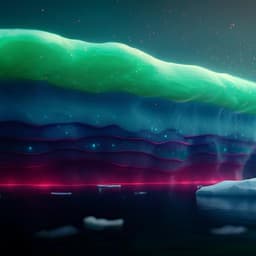
Earth Sciences
Jarosite formation in deep Antarctic ice provides a window into acidic, water-limited weathering on Mars
G. Baccolo, B. Delmonte, et al.
Discover how jarosite, a ferric-potassium hydroxide sulfate found in Martian sediments, has been identified within deep Antarctic ice. This remarkable study, conducted by Giovanni Baccolo, Barbara Delmonte, P. B. Niles, and others, reveals the intriguing interaction between aeolian dust and atmospheric aerosols, shedding light on the geological importance of paleo-ice processes on Mars.
~3 min • Beginner • English
Introduction
Jarosite, a ferric-potassium hydroxide sulfate, is common on Mars but rare on Earth. Its occurrence indicates low-temperature, acidic, water-limited weathering, and its preservation requires limited water; higher water/rock ratios transform jarosite to goethite. On Mars, this poses a paradox because basaltic protoliths neutralize acidity unless reactions occur in isolated, water-limited environments. Proposed formation settings include playa-like lacustrine-evaporative basins and volcanic fumarolic systems. An alternative hypothesis suggests jarosite forms through weathering of basaltic dust trapped within massive ice, where cryo-concentration of sulfur-rich aerosols sustains acidity. Although experiments show elevated cryogenic weathering rates and Antarctic occurrences of jarosite in surface varnishes and meteorite rinds, authentic englacial formation had not been documented. This study asks whether jarosite can form in situ within deep Antarctic ice via englacial weathering of dust and, if so, whether this process supports the ice-weathering model for jarosite on Mars and affects interpretation of deep ice-core records.
Literature Review
Since the Opportunity rover’s 2004 discovery at Meridiani Planum, jarosite has been repeatedly identified on Mars and interpreted as evidence of acidic aqueous alteration under water-limited conditions. Preservation constraints imply small-scale and short-lived fluid activity. Proposed terrestrial analogues include playa and volcanic settings; however, basalt–acid interactions challenge sustained acidity unless confined. The ice-weathering model proposes jarosite from acidic brines formed by cryo-concentration inside ice deposits, consistent with experimental evidence of enhanced low-temperature weathering and observations of jarosite in Antarctic rock varnishes, meteorite weathering rinds, and certain soils. Prior ice-core studies noted secondary Fe precipitates and micro-inclusions possibly consistent with jarosite, but a clear, multi-technique confirmation of authigenic jarosite forming englacially had been lacking.
Methodology
- Study site and samples: TALDICE (Talos Dome Ice Core), 1620 m long, from East Antarctica. Samples span the full core; emphasis on >1000 m depth.
- Dust concentration and grain size: 25 cm ice sections decontaminated (triple MilliQ baths). Meltwater mixed with NaCl electrolyte to 1% Na+. Coulter counter (Beckman Multisizer 4, 30 µm orifice) measured insoluble particles 0.6–18 µm in 400 bins. Volume converted to mass assuming 2.5 g/cm3. Blanks ~2.5% of mean sample; replicate SD 5–10%.
- Dust grain size index: From Coulter data, 16 granulometric variables defined. PLS-DA used to distinguish upper (0–1450 m) vs lower (1450–1620 m) core; first latent component provided a grain size index highlighting granulometric anomalies at depth.
- X-ray absorption spectroscopy (XAS): Fe K-edge XAS at B18 beamline (Diamond Light Source) on dust collected by filtration (polycarbonate membranes, 0.4 µm). Fluorescence mode, 7000–7500 eV, 0.3 eV steps; beam 0.4×0.4 mm, Vortex 4-element detector. Energy calibrated to Fe foil (7112.0 eV). At least 3 spectra per sample. Spectra processed and normalized in Athena; Fe K-edge position defined at 0.8 normalized height.
- Jarosite quantification by linear combination fitting (LCF): Transmission-mode Fe K-edge spectra on mineral standards (e.g., jarosite, goethite, hematite, magnetite, silicates, sulfides). Combinatoric OLS LCF in Athena used to reproduce sample spectra with up to 4 standards, forcing goethite presence. Jarosite contribution expressed as the % coefficient in fits; OLS standard error reported.
- Electron microscopy: SEM-EDX (Zeiss Gemini 500 FE-SEM, Bruker Quantax EDX) on dust filtered on polycarbonate membranes; Au coat for morphology, C coat for EDX. STEM-EDX (JEOL 2500SE 200 kV) on epoxy-embedded, thin-sectioned particles from >1500 m depth; selected-area electron diffraction (SAED) to confirm crystal identity; quantitative EDX using thin-film k-factors. Elemental mapping performed to distinguish precipitates vs cores.
- Data analysis: Correlations assessed among Fe oxidation (Fe K-edge), jarosite contribution, δ18O, dust concentration, and ice-crystal size. Records aligned on AICC2012 chronology.
Key Findings
- First robust identification of authigenic jarosite in deep Antarctic ice (>1000 m) from TALDICE, adhering to silica-rich dust particles.
- Fe oxidation increases with depth: average Fe K-edge energies shift from 7125.5(0.5) eV (0–1000 m, n=20) to 7126.5(0.4) eV (1000–1300 m, n=18) and 7127.2(0.3) eV (1300–1620 m, n=16), implying a 30–40% increase in Fe3+. Between 0 and 1000 m, Fe is ~70% Fe3+ / 30% Fe2+; below ~1500 m only Fe3+ is detected.
- Jarosite depth profile: Above 1033 m, only 1 of 22 samples shows jarosite evidence. Between 1033–1500 m, jarosite contribution rises and becomes dominant in Fe-related XAS fits; below 1500 m, jarosite contribution stabilizes at a mean of 54% with SD 8%.
- Microscopy: SEM-EDX reveals micrometric to submicrometric precipitates on dust, including hexagonal platelets consistent with jarosite morphology. Elemental maps show precipitates enriched in Fe, S, K, attached to Si- (and minor Al-) rich cores; Mg, Ca, Na largely absent, consistent with acid leaching and removal as soluble salts.
- STEM-EDX and SAED confirm jarosite identity and near-stoichiometric composition (KFe3(SO4)2(OH)6) as bladed crystals.
- Climate decoupling: Fe oxidation and jarosite abundance show no correlation with δ18O (R2 < 0.02) but correlate with increasing ice-crystal size (R2 = 0.55 and 0.49, respectively), indicating control by englacial metamorphism rather than external climate.
- Grain size changes: A dust grain size index highlights deeper samples have coarser tails and fewer fine particles, consistent with chemical aggregation cemented by jarosite. The δ18O–dust linear R2 drops from 0.75 (0–1400 m) to 0.44 below 1400 m, suggesting degradation of climatic signal preservation at depth.
- Englacial process: Evidence supports formation in localized acidic brines at grain boundaries due to recrystallization-driven impurity concentration, potentially aided by pyrite oxidation to sulfuric acid.
- Stability and threshold: Jarosite increases from ~1000 to ~1400 m (≈100 kyr) and remains stable deeper, implying persistent, localized acidic brines. Formation appears to have a depth threshold near 1000 m, likely tied to onset of impurity co-location and brine stability rather than pressure or temperature alone.
Discussion
The observations demonstrate that deep Antarctic ice hosts active, localized englacial diagenesis capable of oxidizing Fe and precipitating jarosite on dust grains. Ice recrystallization concentrates incompatible impurities (sulfates, acids) at grain junctions and within inclusions, creating isolated microenvironments where pressure melting is locally depressed and acidic brines form. These brines react with Fe-bearing basaltic/doleritic dust, dissolving primary phases and precipitating jarosite along with amorphous silica, consistent with the elemental distributions and textures observed. A likely additional acid source is pyrite oxidation producing sulfuric acid and Fe3+, matching the progressive Fe K-edge shift.
Fe oxidation and jarosite abundance correlate with ice-grain size (a proxy for metamorphism) rather than climate proxies, implicating internal ice processes. The depth-dependent emergence of jarosite around 1000 m suggests a threshold where impurity migration and brine stability allow reaction progress; once formed, jarosite remains stable under highly saline, acidic, water-limited conditions, consistent with the lack of conversion to goethite.
These processes can modify dust grain size distributions (aggregation/cementation), potentially degrading the fidelity of dust-based paleoclimate proxies in the deepest sections, as indicated by reduced δ18O–dust coupling. The findings also bear on meteorite weathering in Antarctic blue ice fields: jarosite-rich rinds may partly form englacially at meteorite–ice interfaces under similar conditions, potentially recording residence depth/time.
Crucially, the demonstrated englacial weathering pathway provides strong terrestrial support for the Martian ice-weathering model: in massive Martian ice-dust deposits, cryogenic brines derived from sulfur-rich aerosols interacting with basaltic dust could precipitate jarosite. While oxidants differ (air bubbles/clathrates on Earth vs oxychlorine photo-oxidants on Mars), the essential ingredients—cold temperatures, isolated microenvironments, limited water, acidity—are analogous. This mechanism challenges playa-based models for widespread Martian jarosite and aligns with the distribution of sulfate-rich, finely layered deposits that may be sublimation residues of past ice-rich units.
Conclusion
This study provides the first multi-technique confirmation of authigenic jarosite formation within deep Antarctic ice, establishing an englacial diagenetic pathway driven by impurity concentration and localized acidic brines at ice-grain boundaries. The results explain progressive Fe oxidation with depth, document abundant jarosite below ~1000 m (stabilizing at ~54% contribution to Fe mineral spectral signal below 1500 m), and reveal microtextural and geochemical signatures consistent with acid weathering of basaltic dust and co-precipitation of amorphous silica. These processes can alter dust granulometry and weaken paleoclimatic dust–isotope relationships in the deepest ice.
The findings substantiate the ice-weathering model for Martian jarosite formation within massive ice-dust deposits and suggest that paleo ice-related processes may have shaped key mineralogical features on Mars. They also imply that jarosite-rich rinds on Antarctic meteorites may record englacial alteration and residence history.
Future work should: (i) survey deeper and multiple Antarctic ice cores to map the englacial stability field of jarosite (especially where carbonates indicate less acidic conditions), (ii) quantify impacts on Fe concentration/speciation proxies and dust-based paleoclimate reconstructions in the “oldest ice” quest, and (iii) investigate meteorite–ice interfaces to separate surficial vs englacial weathering contributions.
Limitations
- Direct detection of liquid brines in deep ice is limited; interpretations rely on indirect evidence (mineralogy, impurity distributions, theory) and localized observations.
- Sample preparation by filtration removes soluble phases, potentially biasing the observed elemental distributions and obscuring coexisting salts.
- The study focuses on a single core (TALDICE); spatial variability across Antarctica and different thermal/impurity regimes remains to be assessed.
- Depth threshold for jarosite formation is inferred; precise controls (e.g., local pressure, impurity concentration, microstructure) are not fully constrained.
- While microscopy and spectroscopy confirm jarosite presence and trends, quantitative phase abundances in bulk dust remain model-dependent (LCF uncertainties).
Related Publications
Explore these studies to deepen your understanding of the subject.







